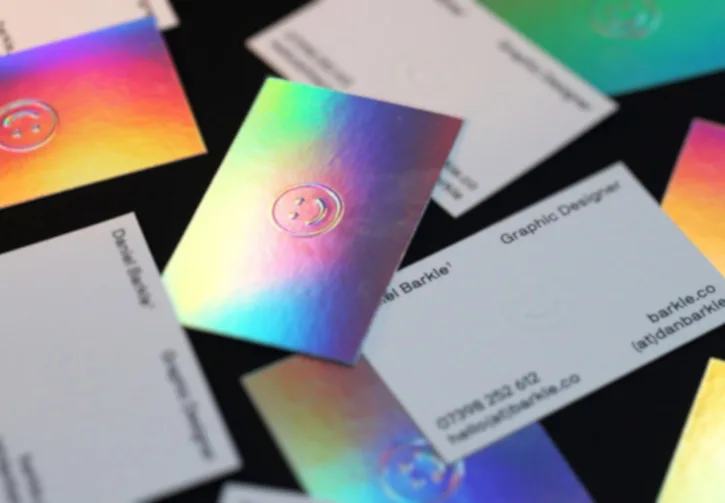Your business card is more than just a piece of paper with your contact information; it’s a representation of your brand and a powerful marketing tool. It’s the first impression you leave with potential clients and colleagues, and it can significantly impact how they perceive your professionalism and credibility.
In this digital age, where online interactions are commonplace, a well-designed physical business card can make you stand out in a sea of digital noise. However, the question remains: should you design your business cards yourself, or should you seek professional help?
In the following sections, we will explore the advantages and disadvantages of both DIY and professional business card design, helping you make an informed decision based on your specific needs and circumstances.
In this article, we will explore DIY vs. Professional Design: Making the Right Business Card Choice. To learn more about Web or App designing , please click the link to our blog post, “A Comprehensive Guide To Mobile App Design Process In 2023”
The Significance of a Well-Designed Business Card
Before diving into the DIY vs. professional design debate, let’s understand why a well-designed business card is essential:
- First Impressions: Your business card is often the first tangible representation of your brand that potential clients or partners receive. It’s a chance to make a strong and positive first impression.
- Brand Identity: A well-designed business card communicates your brand identity, including your logo, colors, and overall aesthetics. This consistency reinforces brand recognition.
- Professionalism: A professionally designed business card conveys a sense of professionalism and attention to detail. It suggests that you take your business seriously.
- Networking: Business cards facilitate networking by providing essential contact information. They are a convenient way for people to reach out to you after a meeting or event.
Now that we’ve established the importance of a well-designed business card, let’s delve into the DIY and professional design options.
DIY Business Card Design: Pros and Cons
Benefits of DIY Design
- Cost-Efficiency: One of the most significant advantages of DIY business card design is the potential for cost savings. You won’t need to pay a professional designer, making it a budget-friendly option for startups and small businesses.
- Creative Control: DIY design gives you complete creative control. You can experiment with various design elements and personalize your business cards to align perfectly with your vision.
Drawbacks of DIY Design
- Limited Expertise: Unless you have design experience, your DIY cards may lack the professional touch that a trained designer can provide. This can affect the overall impression your card leaves on recipients.
- Time-Consuming: Designing your own business cards can be time-consuming, especially if you’re not familiar with design software. Time spent on design might be better invested in other aspects of your business.
Professional Business Card Design: Pros and Cons
Benefits of Professional Design
- Expertise and Quality: Professional designers possess the skills and knowledge to create visually appealing and effective business card designs. Their work is typically of a higher quality.
- Time Savings: Hiring a professional designer frees up your time to focus on what you do best – running your business. You can trust that your cards will be completed efficiently.
Drawbacks of Professional Design
- Cost: Professional design services come at a price, which may not be ideal for businesses with limited budgets.
- Less Personalization: While professional designers can tailor your cards to your brand, you might have less direct influence over the design process compared to a DIY approach.
Factors to Consider Before Making Your Choice
Budget
Consider your budget carefully. If you have the funds available, professional design can provide a polished and impactful result. If finances are tight, DIY design may be your best option.
Brand Identity
Your business card should reflect your brand identity. If you have a well-defined brand style, a professional designer can ensure your cards align perfectly with your brand’s aesthetics.
Time and Expertise
Do you have the time and design expertise required for DIY design? If not, professional design can save you time and potentially yield better results.
Printing Options
Both DIY and professional designs can be printed in various ways. Ensure your chosen design aligns with your preferred printing method and materials.
DIY Business Card Design: Tips and Best Practices
Choosing the Right Software
Use design software that you’re comfortable with and that allows for professional-looking results.
Design Elements and Layout
Keep your design clean and uncluttered. Pay attention to spacing, alignment, and overall layout.
Typography and Fonts
Select legible fonts and maintain consistency in font usage. Typography plays a crucial role in readability.
Color Schemes
Choose colors that resonate with your brand and are visually appealing. Ensure there’s good contrast for text readability.
Incorporating Your Brand
Include your logo and brand colors to reinforce brand recognition.
DIY Design Tools and Resources
Take advantage of design tools and resources available online. Many templates and tutorials can assist you in creating effective business card designs.
Professional Business Card Design: What to Expect
Choosing professional design services for your business cards offers several advantages. Here’s what you can expect:
Finding the Right Designer
Before diving into the design process, you’ll need to find a skilled designer or design agency. Look for professionals with a strong portfolio and a style that aligns with your brand.
Communicating Your Vision
Clear communication with your designer is key. Be prepared to share your vision, brand identity, and any specific ideas you have for your business cards.
The Design Process
Professional designers will typically follow a structured design process, which includes concept creation, layout design, font selection, and color choices. They will ensure that your business cards are visually appealing and in line with your branding.
Revisions and Finalization
Professional designers often offer revision rounds to fine-tune the design. This ensures that the final product meets your expectations and branding requirements.
Comparing Costs: DIY vs. Professional Design
To make an informed decision, it’s crucial to understand the costs associated with both DIY and professional business card design.
Estimating DIY Expenses
DIY design costs may seem minimal at first, primarily involving software subscriptions, stock photo purchases, and printing expenses. However, your time and effort should also be factored in.
Understanding Professional Design Costs
Professional design services come with a fee, which varies based on the designer’s experience and the complexity of the project. While it may seem like a larger upfront investment, professional design can lead to higher-quality, more effective business cards.
Case Studies: DIY vs. Professional Business Cards
Let’s take a closer look at real-world scenarios to understand the outcomes of both DIY and professional business card design.
DIY Success Stories
DIY design can yield positive results if you have graphic design skills and access to design software. However, be mindful of the time you invest and the learning curve associated with design tools.
Professional Design Success Stories
Professional designers bring expertise and creativity to the table. Their work often results in business cards that stand out, leave a lasting impression, and align perfectly with your brand.
Making Your Decision: DIY or Professional Design?
Scenario 1: Startups and Small Businesses
For startups and small businesses with limited budgets, DIY business card design can be an appealing option. Many online tools and templates make it relatively easy to create a basic but functional card. However, keep in mind that while DIY cards can save money upfront, they may not convey the level of professionalism that some established businesses or industries demand.
Scenario 2: Established Businesses
Established businesses often benefit from the expertise of professional graphic designers. These designers can craft business cards that align perfectly with the company’s branding and messaging. High-quality design and printing can set a business apart from its competitors and leave a lasting impression on clients and partners.
Scenario 3: Creative Professions
Individuals in creative professions, such as graphic designers or artists, may prefer the DIY route to showcase their unique skills and creativity. DIY business cards can serve as a canvas for personal expression, allowing for unconventional and eye-catching designs that capture attention.
Scenario 4: Budget Constraints
Budget constraints are a significant factor in the decision-making process. While professional design and printing services typically cost more, they often yield higher-quality results. If your budget allows, investing in professionally designed and printed business cards can pay off in the long run through improved brand perception and client trust.
DIY Business Card Printing: Tips and Recommendations
If you decide to go the DIY route for designing your business cards, here are some essential tips and recommendations:
- Choosing the Right Paper: The choice of paper can significantly impact the look and feel of your business card. Opt for a sturdy and high-quality paper stock that complements your design.
- Keep It Simple: Less is often more when it comes to business card design. Avoid clutter and excessive information. Focus on essential details like your name, contact information, and a concise tagline if applicable.
- Consistency: Ensure that your business card design aligns with your overall brand identity. Use consistent fonts, colors, and branding elements to maintain a cohesive look.
- Professional Printing: If possible, consider professional printing services, even for your DIY design. Professional printers can ensure color accuracy and provide a polished finish.
Printing at Home vs. Professional Printing
When it comes to printing your business cards, you’ll face a choice between printing at home or using professional printing services.
- Printing at Home: This option is cost-effective and allows for more immediate adjustments to your design. However, the quality may not match that of professional printing, and you may encounter challenges with color accuracy and paper handling.
- Professional Printing: Professional printing services offer a higher level of precision, quality, and finishing options. They can accommodate various paper stocks, finishes, and even specialty features like embossing or foil stamping. While this option may be pricier, it ensures a polished and professional result.
Cutting and Trimming
DIY:
If you opt for a DIY business card design, you’ll likely handle the cutting and trimming yourself. This can be a cost-effective approach, but it requires precision and attention to detail. Investing in a high-quality paper cutter and a steady hand is essential to ensure your cards have clean edges.
Professional:
Professional designers work with precision equipment and have experience in producing perfectly cut and trimmed business cards. They can also help you choose the right paper type and finish for a polished final product.
Common Mistakes to Avoid in Business Card Design
DIY:
Designing your business cards without professional guidance can lead to common mistakes such as using low-resolution graphics, cluttered layouts, or unreadable fonts. DIY designs may not always adhere to design principles that ensure a visually appealing and effective card.
Professional:
Professional designers are well-versed in design principles and can steer you away from common pitfalls. They ensure that your business card is not only visually appealing but also communicates your brand effectively.
Rebranding and Updating Your Business Cards
DIY:
If you decide to rebrand or make updates to your business card, DIY designs can be more flexible and cost-effective for making small changes. However, major overhauls may require starting from scratch.
Professional:
Professional designers can seamlessly adapt your business card to your evolving brand identity. They have the tools and expertise to implement comprehensive changes while maintaining a consistent look and feel.
How to Make Your Business Card Stand Out
DIY:
DIY designs can be creative and unique, allowing you to experiment with unconventional ideas. However, achieving a polished, standout look may be challenging without professional design skills.
Professional:
Professional designers have a wealth of experience in creating eye-catching business cards. They know how to balance creativity with professionalism to ensure your card grabs attention for all the right reasons.
Tips for Networking with Your Business Card
DIY:
When networking with DIY business cards, it’s crucial to be confident in your card’s design and quality. Explaining your DIY approach can even become a talking point during conversations.
Professional:
Having professionally designed cards exudes confidence and competence. Networking becomes more effortless as your well-designed card reflects positively on your brand.
The Future of Business Cards: Digital vs. Traditional
Traditional Business Cards
Traditional business cards have been a staple of professional networking for decades. They are physical, tangible representations of your brand or business that you can hand out during meetings, conferences, or chance encounters. Here are some key considerations when it comes to traditional business cards:
Pros:
- Tangible Impressions: A well-designed traditional business card can leave a memorable and tangible impression on the recipient, making it easier for them to recall your brand or services.
- Personal Touch: Handing out a physical card adds a personal touch to your interactions, signaling that you are invested in the relationship.
- Accessibility: Not everyone may have a smartphone or the necessary apps to exchange digital information, making traditional cards accessible to a wider audience.
Cons:
- Cost and Environmental Impact: Printing and distributing traditional business cards can be costly, and it has an environmental impact due to paper usage.
- Limited Information: Traditional cards have limited space for information, which may restrict your ability to convey all relevant details about your business.
Digital Business Cards
With the advent of smartphones and digital networking, digital business cards have gained popularity. These are typically created and shared through mobile apps or email signatures. Here are some considerations for digital business cards:
Pros:
- Eco-Friendly: Digital cards eliminate the need for paper and are more environmentally friendly.
- Easy Updates: You can easily update your contact information and other details without the need for reprints.
- Rich Media: Digital cards can include links to your website, portfolio, or social media profiles, offering a richer experience.
Cons:
- Dependent on Technology: Both you and the recipient must have access to smartphones and digital tools for the exchange to be effective.
- Less Personal: The exchange of digital cards may feel less personal compared to handing over a physical card.
Suggested reading: How Much Does Website Redesign Cost In 2023 – An Overview
Conclusion: Your Business Card, Your Choice
In the end, the choice between DIY and professional design, as well as between traditional and digital business cards, should align with your business goals, budget, and personal preferences. Here are some key takeaways:
- If you have design skills and a limited budget, DIY business card design can be a viable option, especially for startups and small businesses.
- Consider professional design if you want a polished, unique, and highly customized business card that reflects your brand’s identity.
- Traditional cards can create a more personal and lasting impression, while digital cards offer convenience and eco-friendliness.
- Ultimately, the effectiveness of your business card design will depend on how well it represents your brand and how confidently you use it in networking situations.
- Remember that your business card is a reflection of you and your brand. Whichever option you choose, ensure that it aligns with your professional image and helps you make memorable connections in the business world.
In conclusion, when it comes to creating business cards, the choice between DIY and hiring a professional designer is a crucial one. At Complete Gurus, we offer the services of expert business card designers at the most affordable cost. While DIY can be a viable option for those on a tight budget, it’s important to remember that your business card is often the first impression you make on potential clients or partners. A professionally designed business card can convey a sense of professionalism, credibility, and attention to detail that DIY options may not achieve.
Our team of skilled designers understands the nuances of effective business card design, ensuring that your cards not only look visually appealing but also effectively represent your brand. With our affordable rates, you can access top-notch design services that will set you apart in a competitive business landscape.
Ultimately, the decision between DIY and professional design hinges on your specific needs and goals. We are here to assist you in making the right choice and delivering business cards that leave a lasting and positive impression on your network. Choose Complete Gurus for affordable expertise and elevate your business card game today.

I am Ashutosh – a seasoned digital marketer, bringing digital transformation to businesses, complementing businesses’ growth via generating qualified leads, drive site inbound traffic via organic and inorganic approach, & build their brands through useful, well-designed marketing strategies and Marketing Automation implementation via Chat GPT, HubSpot & Zoho.







